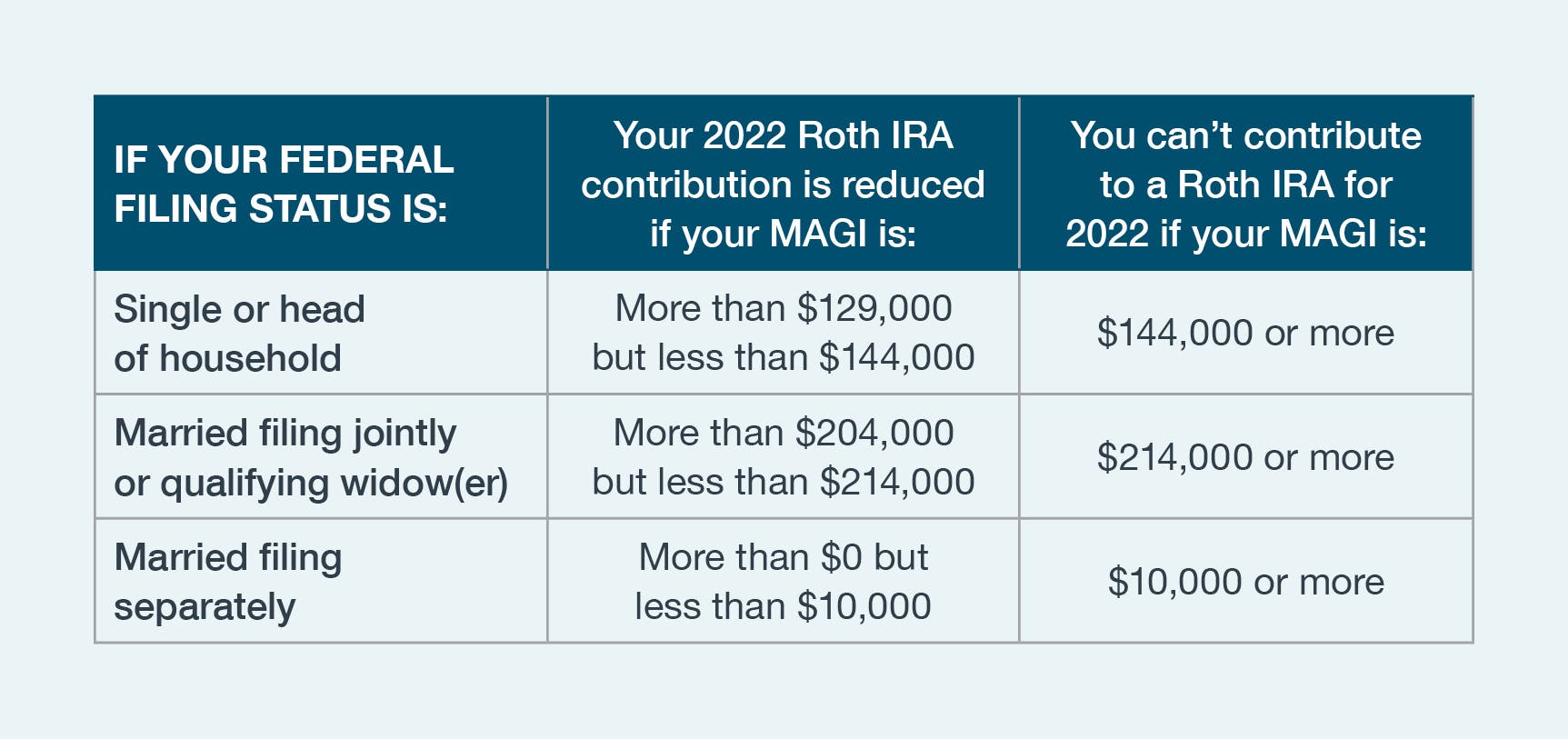
With the potential for tax-free retirement income, Roth IRAs may be appealing investment vehicles.
There are three ways to fund a Roth IRA — you can open an account and contribute directly, you can convert all or part of a traditional IRA to a Roth IRA, or you can roll over or convert funds from an eligible employer retirement plan.
1. OPEN ACCOUNT, CONTRIBUTE DIRECTLY
In general, you can contribute up to $6,000 to an IRA (traditional, Roth, or a combination of both) in 2022 (unchanged from 2021); $7,000 if you’ll be age 50 or older by December 31. However, your ability to make annual contributions to a Roth IRA may be limited (or eliminated) depending on your modified adjusted gross income, or MAGI, as shown in the chart below:

2. CONVERT TRADITIONAL IRA ASSETS
The second way to fund a Roth IRA is to convert a traditional IRA to a Roth IRA. Regardless of your filing status or how much you earn, you can convert a traditional IRA to a Roth IRA.
If your income exceeds the limits that allow you to make direct contributions, you can still potentially benefit from a Roth IRA by using a conversion workaround (sometimes called a “back door” Roth IRA). You would simply make a nondeductible contribution to a traditional IRA and then convert that traditional IRA to a Roth. There are no limits to the number of Roth conversions you can make.
HOW DO YOU CONVERT A TRADITIONAL IRA TO A ROTH?
Start by notifying your existing traditional IRA trustee or custodian that you want to convert all or part of your traditional IRA to a Roth IRA, and the custodian/trustee will provide you with the necessary paperwork. You can also open a new Roth IRA at a different financial institution and then have the funds in your traditional IRA transferred directly to your new Roth IRA. The trustee/custodian of your new Roth IRA can give you the required paperwork. If you prefer, you can instead contact the trustee/custodian of your traditional IRA, have the funds in your traditional IRA distributed to you, and then roll those funds over to your new Roth IRA within 60 days of the distribution. The income tax consequences are the same regardless of the method you choose.
If your income exceeds the limits that allow you to make direct contributions, you can still potentially benefit from a Roth IRA by using a conversion work-around (sometimes called a “back door” Roth IRA).
CALCULATING THE CONVERSION TAX
When you convert a traditional IRA to a Roth IRA, you’re taxed as if you received a distribution, but with one important difference — the 10% early-distribution tax doesn’t apply, even if you’re under age 59½. However, the IRS may recapture this penalty tax if you make a nonqualified withdrawal from your Roth IRA within five years of your conversion.
If you’ve made only nondeductible (after-tax) contributions to your traditional IRA, then only the earnings, and not your own contributions, will be subject to tax at the time you convert the IRA to a Roth. But if you’ve made both deductible and nondeductible IRA contributions to your traditional IRA, and you don’t plan on converting the entire amount, things can get complicated. Under IRS rules, the amount you convert is deemed to consist of a pro-rata portion of the taxable and nontaxable dollars in the IRA.
For example, assume that your traditional IRA contains $350,000 of taxable (deductible) contributions, $50,000 of nontaxable (nondeductible) contributions, and $100,000 of taxable earnings. You can’t convert only the $50,000 nondeductible (nontaxable) contributions to a Roth and have a tax-free conversion. Instead, you’ll need to pro-rate the taxable and nontaxable portions of the account. So in the example above, 90% ($450,000/$500,000) of each distribution from the IRA (including any conversion) will be taxable, and 10% will be nontaxable.
You can’t escape this result by using separate IRAs. Under IRS rules, you must aggregate all of your traditional IRAs (including SEPs and SIMPLEs) when you calculate the taxable income resulting from a distribution from (or conversion of) any of the IRAs.
3. ROLL OVER OR CONVERT EMPLOYER PLAN FUNDS
You can also roll over or convert funds from an employer plan [such as a 401(k)] to a Roth IRA. You can roll over amounts held in a Roth employer plan account directly to a Roth IRA, or you can convert non-Roth funds to a Roth IRA. Like traditional IRA conversions, the amount you convert will be subject to income tax in the year of conversion (except for any after-tax contributions you’ve made).
IS A ROTH IRA RIGHT FOR YOU?
The answer to this question depends on many factors, including your current and projected future income tax rates, the length of time you can leave the funds in the Roth IRA without taking withdrawals, your state’s tax laws, and how you’ll pay the income taxes due at the time of the conversion.
CHRIS KELLY
CPA, CFP®, M.Accy
Financial Advisor, Portfolio Manager & Executive Manager
ckelly@bwfa.com


